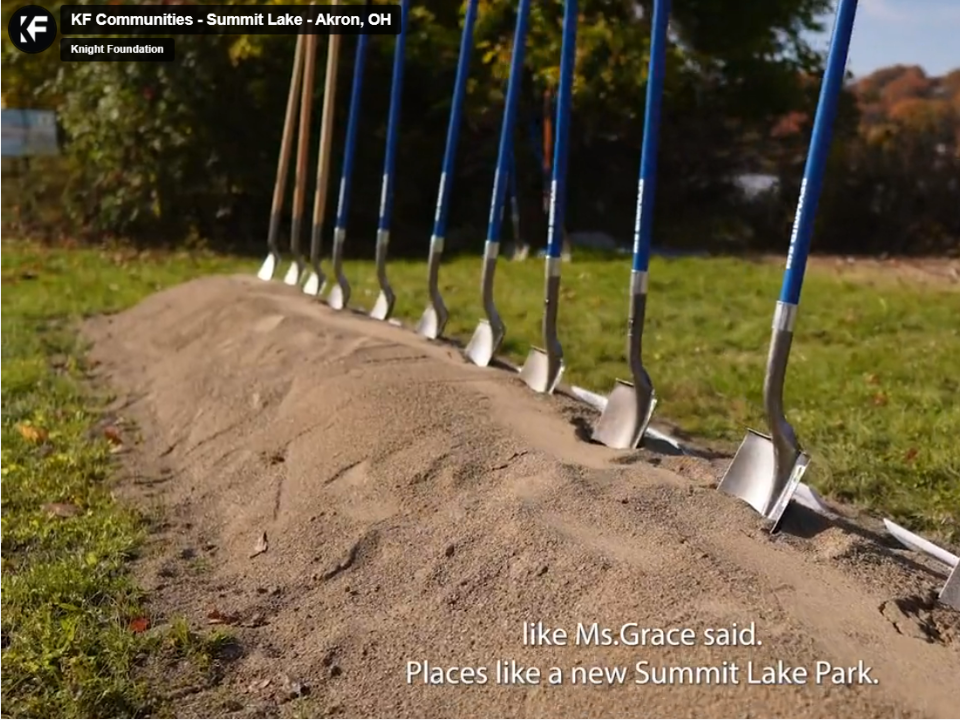
Ahead of Give Local America, 7 trends in Giving Days
A school principal rides a zipline as a way to bring attention to Give to the Max Day in Minnesota. Courtesy of GiveMN Day.
With the clock ticking for Give Local America on May 5, community foundations and others are finalizing plans for this national day of online giving. At Knight Foundation, we’ve been providing insights on organizing successful Giving Days, and wanted to share the latest information we have gathered.
Our work started with The Giving Day Playbook, a soup-to-nuts guide that is continuously updated. Today, we wanted to share insights from six 2014 Fall Giving Days supported by Knight.
Our interest is not just on democratizing philanthropy, as essential as that is. While we’re excited by new trends in donor activity, that I’ll outline below, we also want to make sure that community foundations find ways to make these campaigns sustainable for themselves.
The Giving Day analysis, conducted by Third Plateau Social Impact Strategies, looked at Giving Days run by the Blue Grass Community Foundation, Community Foundation of Central Georgia, Community Foundation of the Chattahoochee Valley, Community Foundation Serving Boulder County, Duluth Superior Area Community Foundation and GiveMN, The Miami Foundation and Mississippi Gives.
It revealed several interesting trends in both donor activity and sustainability:
Nonprofits are bringing in new donors: All six of the Giving Days continue to attract new donors for their participating nonprofits. During Blue Grass Community Foundation’s Good Giving Guide Challenge in Lexington, 95 percent of participating nonprofits reported having at least one new donor.
New waves of philanthropists are contributing: After Give to the Max Day in Minnesota, 5 percent of donors surveyed said the day was their first time donating to a cause. Give to the Max helped achieve that this year by reaching out to commuters on buses and trains, a new audiences for the nonprofits and the Giving Day. And the analysis showed that nonprofits aren’t just getting new donors. They also reported the Giving Days helped increase their overall donations for the year.
More people are giving less: Although the Giving Days exceeded their amounts raised over the previous year, the data show that more people are donating smaller amounts, with the average contribution decreasing by 6 percent. While Giving days aim to democratize philanthropy – often making it very easy to participate by setting a low bar of say $25 to participate – this may be leading to more, smaller donations.
Community Foundations are not using the days to raise money for themselves: Five out of the six community foundations did not list themselves as potential donation recipients during their campaigns. This is a critical piece when we look at the financial sustainability of Giving Days. The Community Foundation Boulder County did – and raised $43,600 through 201 donations.
So what can community foundations do to increase the financial stability of these campaigns? The foundations we surveyed experimented with a few ways:
Tipping: This is a relatively new trend for Giving Days. GiveMN’s Give to the Max Day and the Blue Grass Community Foundation allowed for donors to add a tip at checkout to support the foundation’s general operations. Both felt this was an easy and noninvasive way to leverage additional resources for the community foundation.
Processing fees: Another way community foundations are looking to strengthen the cost-effectiveness of Giving Days is through fees. While many Giving Day organizers have covered processing fees for participating nonprofits, none of the six surveyed did last fall. This was a risk for the community foundations as they were initially concerned about impacting nonprofit participation. But The Miami Foundation and Boulder an increase in participating nonprofits and overall amount raised.
Participation fees: Blue Grass Community Foundation charged participating nonprofits a $500 fee for its Giving Day, raising $77,500. This is a relatively new trend among Giving Days, and something worth considering as a way to cover costs.
As we approach next year’s campaigns, we will continue to explore how Giving Days evolve. In Knight-supported communities, we have asked foundations to experiment with new paths to sustainability, and we will be funding several of these in the coming year. We look forward to sharing these projects with you soon.
Are you a Giving Day organizer? Join our Giving Day Exchange Facebook group and swap ideas with peers.
Michelle Huttenhoff is a program assistant in Knight Foundation’s community foundations program.
Recent Content
-
Communities / Article
-
Communities / Article
-
Communities / Article



